E1_Lab_4_5_1_in
- 格式:doc
- 大小:394.00 KB
- 文档页数:7


护理学专升本业余班《大学英语》试题您的姓名: [填空题] *_________________________________plete each statement by choosing the appropriate answer from the 4 choices marked A, B, C and D. (单项选择) 20×2分=40%1. These students have little _____for how others look at them.() [单选题] *A. concern(正确答案)B. thoughtC. thinkingD. consideration2. An oversea student studies____.() [单选题] *A. aboardB. abroad(正确答案)C. at homeD. at sea3. I was___ in a small countryside in China. () [单选题] *A. brought up(正确答案)B. bring upC. raised upD. raise up4. The foreign teachers usually have their meals at the school ___.() [单选题] *A. libraryB. labC. bookshopD. canteen(正确答案)5. The food in the canteen is ___ .() [单选题] *A. delightedB. detailedC. decidedD. delicious(正确答案)6. Chinese martial arts are___ great interest ___ many foreigners.() [单选题] *A. in…toB. of… to(正确答案)C. in… inD. of…in7. The morning flight is ____ to us as we will arrive in time to attend the afternoon meeting. () [单选题] *A. suitable(正确答案)B. quickC. directD. inclusive8. Are there still tickets ___ on the morning flight to Shenzhen?() [单选题] *A. freeB. suitableC. available(正确答案)D. ready9. Technicians with good skills are always ___.() [单选题] *A. on the demandB. on demandC. in the demandD. in demand(正确答案)10.Miss Yang is likely to be ____ for promotion.() [单选题] *A. sentB. recommended(正确答案)C. advisedD. reported11. Mr. Liu works with a travel agency as a ____. () [单选题] *A. tourist guideB. tour guide(正确答案)C. travel guideD. trip guide12. One cannot judge a person only by his _____ conditions.() [单选题] *A. economicalB. economicsC. economic(正确答案)D. economy13. Department stores offer a big ____ of items.() [单选题] *B. typeC. variety(正确答案)D. model14. They sold the old furniture to make ___ for the new.() [单选题] *A. a roomB. a spaceC. room(正确答案)D. space15. The garment in the department store are so expensive that I can’t ___ them.() [单选题] *A. buyB. purchaseC. afford(正确答案)D. take16. They ___ good friends and often visited each other. () [单选题] *A.are used to beingB.B. are used to beC. used to beingD. used to be(正确答案)17. After he ____ the unforgettable failure of love, he became afraid of it.() [单选题] *A. feltB. forgetD. experienced(正确答案)18. There is a ___ of two hours with the 7:40 train.() [单选题] *A. delay(正确答案)B. changeC. schedule.D. timetable19. John is busy ______ his girlfriend with her paper.() [单选题] *A. to helpB. helping(正确答案)C. helpD. helps20. We soon arrived _____ the airport.() [单选题] *A. inB. toC. onD. at(正确答案)II. Reading comprehension(阅读理解) 10×3分=30%Task 1We are one of the most well-known computer companies in the world. We need someone who can work as a secretary in our Beijing office. We are looking for someone who is about twenty-five years old (male or female). We need someone who can understand and speak English and Japanese. He or she should be able to use a computer and to drive a car. Work experience are not required. We can make appointments to meet applicants. If you are interested in working with us, please call us at 010-******** between July 14th and18th.The following is an advertisement of a computer company. After reading it, you should complete the information by filling in the blanks marked 1 through 5 in the table blow. (根据这则广告内容填空)Age: 1 [填空题] *_________________________________(答案:请设置答案)Qualification: foreign languages: 2 [填空题] *_________________________________(答案:请设置答案)skills: 3 [填空题] *_________________________________(答案:请设置答案)Experiences:4 [填空题] *_________________________________(答案:请设置答案)Contact: 5 [填空题] *_________________________________(答案:请设置答案)Task 2These are some things about myself that really like. First of all, I always make an effort to do my best. I never give up halfway without trying my best. For example, I have practiced the piano for more than twelve years. And now I am learning English everyday. Secondary, I am good at making people laugh. I feel happy when people smile at the things I do. I make friends with anyone easily and now I have a lot of friends.Of course, I also have my weak points. I sometimes feel that I am a bit selfish or careless.I want to overcome these faults and I believe this will make a man of me and people will love me better.For each question or statement there are 4 choices marked A, B, C and D.You are requested to make the correct choice.(选择正确答案)6. What is NOT the author’s character? ____.() [单选题] *A. Always trying his bestB. Being good at making people laughC. Making friends easilyD. Giving up halfway(正确答案)7. He has practiced the piano for _____.() [单选题] *A. less than twelve yearsB. twelve yearsC. almost twelve yearsD. over twelve years(正确答案)8. He is trying to _____ every day.() [单选题] *A. learn English(正确答案)B. play the pianoC. make friendsD. overcome his faults9. He is now trying to overcome the fault of _____.() [单选题] *A. making people laughB. making too many friendsC. being selfish or careless(正确答案)D. being too proud or particular10. He feels _____ when people smile at the things he does.() [单选题] *A. selfishB. angryD. carelessIII. Match the words in Column A with the explanations in Column B. (选出正确的单词解释) 5×2分=10%1. efficient () [单选题] *A. abroadB. having pleasant smell or tasteC. very goodD. working well and without waste(正确答案)E. holiday2.vacation () [单选题] *A. abroadB. having pleasant smell or tasteC. very goodD. working well and without wasteE. holiday(正确答案)3. delicious () [单选题] *A. abroadB. having pleasant smell or taste(正确答案)C. very goodD. working well and without wasteE. holiday4. overseas () [单选题] *B. having pleasant smell or tasteC. very goodD. working well and without wasteE. holiday5.excellent () [单选题] *A. abroadB. having pleasant smell or tasteC. very good(正确答案)D. working well and without wasteE. holidayIV. Translation ( 翻译 ) 4×5分=20%A. Translate English into Chinese ( 英译汉 )1. It won’t be long before they start checking in. [填空题]_________________________________2. She is on another line. Or you may leave a message. [填空题] _________________________________B. Translate Chinese into English. ( 汉译英 )1.周末我们或者去游泳,或者去滑冰。

MPLA B® IDE快速入门指南2008 Microchip Technology Inc.DS51281G_CN请注意以下有关Microchip 器件代码保护功能的要点:•Microchip 的产品均达到Microchip 数据手册中所述的技术指标。
•Microchip 确信:在正常使用的情况下,Microchip 系列产品是当今市场上同类产品中最安全的产品之一。
•目前,仍存在着恶意、甚至是非法破坏代码保护功能的行为。
就我们所知,所有这些行为都不是以Microchip 数据手册中规定的操作规范来使用Microchip 产品的。
这样做的人极可能侵犯了知识产权。
•Microchip 愿与那些注重代码完整性的客户合作。
•Microchip 或任何其他半导体厂商均无法保证其代码的安全性。
代码保护并不意味着我们保证产品是 “牢不可破”的。
代码保护功能处于持续发展中。
Microchip 承诺将不断改进产品的代码保护功能。
任何试图破坏Microchip 代码保护功能的行为均可视为违反了 《数字器件千年版权法案(Digital Millennium Copyright Act )》。
如果这种行为导致他人在未经授权的情况下,能访问您的 软件或其他受版权保护的成果,您有权依据该法案提起诉讼,从而制止这种行为。
提供本文档的中文版本仅为了便于理解。
请勿忽视文档中包含 的英文部分,因为其中提供了有关Microchip 产品性能和使用 情况的有用信息。
Microchip Technology Inc.及其分公司和相 关公司、各级主管与员工及事务代理机构对译文中可能存在的 任何差错不承担任何责任。
建议参考 Microchip TechnologyInc.的英文原版文档。
本出版物中所述的器件应用信息及其他类似内容仅为您提供便 利,它们可能由更新之信息所替代。
确保应用符合技术规范, 是您自身应负的责任。
Microchip 对这些信息不作任何明示或 暗示、书面或口头、法定或其他形式的声明或担保,包括但不 限于针对其使用情况、质量、性能、适销性或特定用途的适用 性的声明或担保。
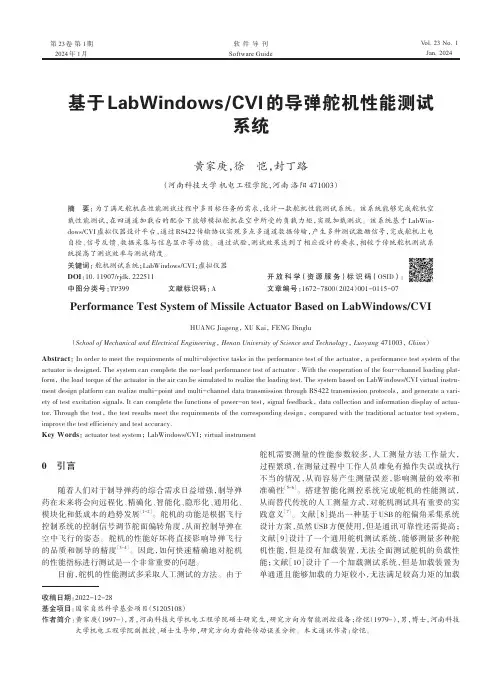
第 23卷第 1期2024年 1月Vol.23 No.1Jan.2024软件导刊Software Guide基于LabWindows/CVI的导弹舵机性能测试系统黄家庚,徐恺,封丁路(河南科技大学机电工程学院,河南洛阳 471003)摘要:为了满足舵机在性能测试过程中多目标任务的需求,设计一款舵机性能测试系统。
该系统能够完成舵机空载性能测试,在四通道加载台的配合下能够模拟舵机在空中所受的负载力矩,实现加载测试。
该系统基于LabWin⁃dows/CVI虚拟仪器设计平台,通过RS422传输协议实现多点多通道数据传输,产生多种测试激励信号,完成舵机上电自检、信号反馈、数据采集与信息显示等功能。
通过试验,测试效果达到了相应设计的要求,相较于传统舵机测试系统提高了测试效率与测试精度。
关键词:舵机测试系统;LabWindows/CVI;虚拟仪器DOI:10.11907/rjdk.222511开放科学(资源服务)标识码(OSID):中图分类号:TP399 文献标识码:A文章编号:1672-7800(2024)001-0115-07Performance Test System of Missile Actuator Based on LabWindows/CVIHUANG Jiageng, XU Kai, FENG Dinglu(School of Mechanical and Electrical Engineering, Henan University of Science and Technology, Luoyang 471003, China)Abstract:In order to meet the requirements of multi-objective tasks in the performance test of the actuator, a performance test system of the actuator is designed. The system can complete the no-load performance test of actuator . With the cooperation of the four-channel loading plat⁃form, the load torque of the actuator in the air can be simulated to realize the loading test. The system based on LabWindows/CVI virtual instru⁃ment design platform can realize multi-point and multi-channel data transmission through RS422 transmission protocols, and generate a vari⁃ety of test excitation signals. It can complete the functions of power-on test, signal feedback, data collection and information display of actua⁃tor. Through the test, the test results meet the requirements of the corresponding design, compared with the traditional actuator test system,improve the test efficiency and test accuracy.Key Words:actuator test system; LabWindows/CVI; virtual instrument0 引言随着人们对于制导弹药的综合需求日益增强,制导弹药在未来将会向远程化、精确化、智能化、隐形化、通用化、模块化和低成本的趋势发展[1-2]。

(文末带答案)高中英语过去完成时时态典型例题及答题技巧单选题1、It was the second time that I________him in Shanghai.A.metB.had metC.would meetD.was meeting2、.By the time Jack returned home from England, his son _____ from college. A.graduatedB.has graduatedC.had been graduatingD.had graduated3、Lady Wang _______ as a secretary for five years in the insurance company before she joined us. A.has workedB.has been workingC.had workedD.would be working4、Father ________ for London on business upon my arrival, so I didn’t see him.A.has leftB.leftC.had leftD.was leaving5、Hardly _____ when she _____ someone knocking at the door.A.did she sit; heardB.had she sat; heardC.had she sat; had heardD.did she sit; had heard6、The manager is said to have arrived back from Paris where he ______ some European partners.A.would meetB.is meetingC.meetsD.had met7、He ____to the lab than he set out to do the experiment.A.has no sooner gotB.no sooner gotC.will no sooner getD.had no sooner got8、By the time he arrived, every one________ medical care.A.has receivedB.have receivedC.had receivedD.would receive9、Hardly to give his lecture when the audience in the lecture hall interrupted him.A.did he beginB.he beganC.had he begunD.he had begun10、Look at the terrible situation I am in!If only I ________ your advice.A.followB.had followedC.would followD.have followed11、That was the fourth time that Mr. Smith __________the Summer Palace.A.has visitedB.visitsC.had visitedD.to visit12、--- Guess what? I happened to meet Fernando the other day.--- If my memory serves me correctly, you ______ each other for ages.A.haven’t seenB.hadn’t seenC.didn’t seeD.don’t see13、Writing out all the invitations by hand was more time-consuming than we______.A.will expectB.are expectingC.expectD.had expected14、If only I _____________ her _____________ that I book an air ticket in advance. I _____________ a slight change in schedule could have such a strong influence on my travel plan.A.followed; plan; don’t expectB.have followed; instruction; didn’t expectC.fo llowed; example; hadn’t expectedD.had followed; advice; didn’t expect15、As things didn’t work out the way we ________, we found ourselves trying to force them and struggling to finish them.A.planB.are planningC.had plannedD.will be planning16、Though I ________ to go abroad for further study, I changed my mind and decided to stay with my family.A.had wantedB.wantedC.would wantD.did want17、The girl, when _____ why she _____ in the exam, just lowered her head and kept silent. A.questioned; was cheatedB.being questioned; was cheatingC.questioned; had cheatedD.being questioned; has cheated18、“Have you ever been to Chongqing?” he asked me.He asked me .A.had I ever been to ChongqingB.have I ever been to ChongqingC.whether I had ever been to ChongqingD.if I have ever been to Chongqing19、Sun Yang, a young Chinese swimming talent, ________ several gold medals before the 2012 London Olympics. A.wonB.has wonC.had wonD.were to win20、The student said there were a few points in the essay he_________impossible to comprehend.A.has foundB.was findingC.had foundD.would find21、—Did you enjoy staying with your friend last week, Lily?—Yes. I ________ with him for a long time.A.haven’t stayedB.didn’t stayC.hadn’t stayedD.wouldn’t stay22、They moved here in 2002.Until then they ________ in the London area.A.livedB.have livedC.were livingD.had lived23、When Mohammed, a friend of mine from the Middle East, first went to the United Kingdom to attend the university, he ______ with women in the same class before.A.had never studiedB.would never studyC.has never studiedD.did not study24、—I hear you won the prize in the English Contest last week.—That was the second time that I ______ the prize.A.have gotB.gotC.getD.had got25、The policeman’s attention was suddenly caught by a small box which ________ placed under the Minister’s car. A.has beenB.was beingC.had beenD.would26、Bob called to tell his mother that he couldn’t enter the house, for he ________ his key at school.A.had leftB.would leaveC.was leavingD.has left27、It was the first time she the piano.A.that, playedB.that, had playedC.when, playedD.when, had played28、Everybody________ before she got to the station.A.has leftB.had leftC.leftD.would left29、Recently, Prince Albert II of Monaco expressed his thanks for the aid they ___________ from China. A.receiveB.are receivingC.have receivedD.had received30、It was the first time that I _______ visitors since I’d moved to London.A.had hadB.have hadC.haveD.had31、—What a consequence!—Yes. I ________ him about it, but without success.A.will remindB.would remindC.was remindingD.had reminded32、I________ to help you with your homework but I couldn’t spare any time. I________ a composition last night and I’l l finish it today.A.wanted;have been writingB.wanted;wroteC.have wanted;wroteD.had wanted;was writing33、Just as I got to the school gate, I realised I ________ my book in the cafe.A.have leftB.had leftC.would leaveD.was leaving34、Ceres remains the largest known asteroids(小行星)in the sky. It means almost 600 miles in diameter. By the end of the nineteenth century, several hundred other asteroids_________.A.were identifiedB.had identifiedC.have been identifiedD.had been identified35、【2018·海淀二模】I _____up my mind what I was going to say in the seminar, but it was cancelled.A.have madeB.had madeC.was makingD.would make36、His earlier concert in Shanghai____a big success.It was the first time the Taiwan singer____a concerton the mainland.A.is;heldB.was;heldC.had been;would holdD.was;had held37、He said that his car________stolen and he________have to telephone the police.A.was; wouldB.has been; willC.had been; wouldD.had been; will38、Li Hua ____ his money for dollars before he went on a holiday in America.A.exchangesB.has exchangedC.will exchangeD.had exchanged39、The little girl _______ her heart out because she _______ her toy bear and believed she wasn't ever going to find it.A.had cried; lostB.cried; had lostC.has cried; has lostD.cries; has lost40、—I am so frustrated that the house we______in for so many years was consumed by the fire.—Come on.Look on the bright side.I feel lucky to have escaped in time.A.would liveB.had livedC.liveD.have lived41、Was it the third time he________ in China, succeeding the show in Beijing last year and his recital in Shanghai in January?A.had performedB.performedC.has performedD.performs42、Janet, who ________ her homework, was allowed to play badminton on the playground.A.will finishB.finishC.has finishedD.had finished43、After the experts ________ a whole year on the traffic issue, they finally came to a solution.A.had spentB.were spendingC.have spentD.would spend44、 _____ for the fact that she got hit by a car and broke her leg on her way to school, she might have passed the exam.A.Had it not beenB.Were it notC.Was it notD.Hadn’t it been45、________ could be judged from her eyes, she was terribly sorry for what she________.A.As; had doneB.That; didC.As; has doneD.It; had done(文末带答案)高中英语过去完成时时态_00A参考答案1、答案:B解析:考查动词时态。

USB DriverInstallation Guide for Telit LTE DevicesUSB DRIVER INSTALLATION GUIDE FOR TELIT LTE DEVICESUSB Driver Installation Guide for Telit LTE DevicesFor the following devices:MTSMC-L1G2D-U,MTSMC-LAT3-U,MTSMC-LVW3-U,MTSMC-MNG6-U,MTSMC-MNA1-U,MTSMC-L4N1-U,MTSMC-L4E1-U, MTQ-L1G2D-B02,MTQ-LAT3-B01,MTQ-LAT3-B02,MTQ-LVW3-B01,MTQ-LVW3-B02,MTQ-MNG6-B02,MTQ-MNA1-B01,MTQ-MNA1-B02,MTC-L4G2D-B03, MTC-LNA4-B03,MTC-LEU4-B03,MTC-MNG6-B03,MTC-MNA1-B03,MTCM-L1G2D-B03,MTCM-LAT3-B03,MTCM-LNA3-B03,MTD-MNA1S000616,Version2.3CopyrightThis publication may not be reproduced,in whole or in part,without the specific and express prior written permission signed by an executive officer of Multi-Tech Systems,Inc.All rights reserved.Copyright©2023by Multi-Tech Systems,Inc.Multi-Tech Systems,Inc.makes no representations or warranties,whether express,implied or by estoppels,with respect to the content,information, material and recommendations herein and specifically disclaims any implied warranties of merchantability,fitness for any particular purpose and non-infringement.Multi-Tech Systems,Inc.reserves the right to revise this publication and to make changes from time to time in the content hereof without obligation of Multi-Tech Systems,Inc.to notify any person or organization of such revisions or changes.TrademarksMulti Tech and the Multi-Tech logo are registered trademarks of Multi-Tech Systems,Inc.All other brand and product names are trademarks or registered trademarks of their respective companies.Contacting MultiTech****************************************+1(763)785-3500+1(763)717-5863Websitehttps://Knowledge BaseFor immediate access to support information and resolutions for MultiTech products,visit https:///kb.go.Support PortalTo create an account and submit a support case directly to our technical support team,visit:https://.WarrantyTo read the warranty statement for your product,visit https:///legal/warranty.World HeadquartersMulti-Tech Systems,Inc.2205Woodale Drive,Mounds View,MN55112USACONTENTS ContentsChapter1–LTE Cat4and Cat1Intel Based Devices (4)Installing on Linux (4)Troubleshooting Linux (4)Chapter2–LTE Cat4,Cat1and Cat M1Qualcomm Based Devices (5)Installing on Linux (5)Manually Adding Option Driver (5)Troubleshooting Linux (5)Chapter3–Windows Drivers (7)WHQL Windows Driver (7)Downloading the Windows USB Driver (7)Installing on Windows11and10 (7)Uninstalling Windows Drivers (8)Windows11and10 (8)Remove Microsoft Installed Drivers (8)LTE CAT4AND CAT1INTEL BASED DEVICESChapter1–LTE Cat4and Cat1Intel Based Devices Installing on LinuxThis chapter applies to certain LTE Cat4and Cat1devices,including the following models:-LAT3,-LVW3,-LNA3,-LNA4,and-LEU4.The Linux OS includes a generic USB driver for modems supporting CDC/ACM.To install the device on Linux Kernel2.6.x and newer with CDC/ACM support,connect USB cable from the device toa USB port on your computer.For most recent Linux distributions,there are no drivers to install.If the operating system recognizes the modem,up to seven devices are created(assuming no other ACM values have been assigned):/dev/ttyACM0/dev/ttyACM1/dev/ttyACM2/dev/ttyACM3/dev/ttyACM4/dev/ttyACM5/dev/ttyACM6Only the following devices can be used for AT commands:/dev/ttyACM0(data port for PPP connections and AT commands)/dev/ttyACM3(generic port for AT commands)Troubleshooting LinuxIf Linux does not create devices,check for the kernel module:#lsmod|grep cdc_acmIf entries aren't found,load the kernel module with root privileges:#modprobe cdc-acmIf this returns an error response,such as#FATAL:Module cdc-acmnot found,the kernel module is not on your system.You will need to build the driver.LTE CAT4,CAT1AND CAT M1QUALCOMM BASED DEVICES Chapter2–LTE Cat4,Cat1and Cat M1Qualcomm Based DevicesInstalling on LinuxThis section applies to certain LTE Cat4,Cat1and Cat M1devices.This includes the following models: -L4G2D,-L4N1,-L4E1,-L1G2D,-MNA1,-MNG2and-MNG6.Beginning with Linux Kernel3.18,an LTE driver named option was included in Linux.If using an older version of Linux,build an updated option driver.Manually Adding Option DriverLoad the option driver manually by issuing the following command or including it in the Linux startup scripts: modprobe optionecho1bc71101>/sys/bus/usb-serial/drivers/option1/new_idFor the LE910C1-WWXD and LE910C4-WWXD(L4G2D and L1G2D)use this command:echo1bc71031>/sys/bus/usb-serial/drivers/option1/new_idFor the LE910C4-NF and LE910C4-EU(L4N1and L4E1)use this command:echo1bc71201>/sys/bus/usb-serial/drivers/option1/new_idFor the ME910G1-WW(MNG6)use this command:echo1bc7110A>/sys/bus/usb-serial/drivers/option1/new_idFor the ME910C1-NA and ME910C1-WW(MNA1and MNG2)use this command:echo1bc71101>/sys/bus/usb-serial/drivers/option1/new_idIf the operating system recognizes the modem,devices named/dev/ttyUSBx are created,for example: /dev/ttyUSB0/dev/ttyUSB1/dev/ttyUSB2/dev/ttyUSB3/dev/ttyUSB4Note:-MNG6devices installed/dev/ttyUSB0-3onlyOnly the following devices can be used for AT commands:/dev/ttyUSB2(data port for PPP connections and AT commands)/dev/ttyUSB3(generic port for AT commands)Note:Tested with Linux kernel4.4.0-176-genericTroubleshooting LinuxIf Linux does not create devices,check for the kernel module:#lsmod|grep optionLTE CAT4,CAT1AND CAT M1QUALCOMM BASED DEVICESIf entries aren't found,load the kernel module with root privileges:#modprobe optionCheck dmesg output to see that the radio was detected:#dmesg|grep optionusbcore:registered new interface driver optionoption1-2.3:1.0:GSM modem(1-port)converter detectedoption1-2.3:1.2:GSM modem(1-port)converter detectedoption1-2.3:1.3:GSM modem(1-port)converter detectedoption1-2.3:1.4:GSM modem(1-port)converter detectedoption1-2.3:1.5:GSM modem(1-port)converter detectedoption1-2.3:1.6:GSM modem(1-port)converter detectedIf this returns an error response,the kernel module is not on your system.You will need to build the driver.WINDOWS DRIVERSChapter3–Windows DriversWHQL Windows DriverFor some devices,download options include a WHQL driver for Windows10and Windows11.WHQL drivers have been tested and signed by a Windows Hardware Quality Lab.Windows uses digital signatures to verify the driver package integrity.You may use the Windows Desktop driver,the WHQL Windows10driver,or the WHQL Windows11driver for32-and64-bit systems.If using the Windows Desktop driver,Windows displays a security warning dialog box during the installation process.You can click to install the driver software anyway.You do not get the prompt with the WHQL drivers.Downloading the Windows USB DriverIf you haven't downloaded the driver:1.Go to and search to find your device's model page.Your device's model number is on theproduct label.2.Under Downloads,click on:WindowsDesktopDriversInstallerWindows10WHQLDriversInstaller for the Windows10signed driverWindows11WHQLDriversInstaller for the Windows11signed driver3.A popup window appears.Click to Download the driver zip file to your computer.4.Extract the files to your computer.Installing on Windows11and10This process installs multiple drivers and ports.You need administrator rights to install drivers.Note:If you previously installed USB drivers for this device,uninstall them before installing or re-installing this driver.Uninstall all existing drivers for this device.Refer to Uninstall Windows Drivers for details.Before you connect the device(disconnect the device if you connected it):CAUTION:If you connected the device before installing the drivers,Windows may install drivers automatically.Your device may not operate correctly with these drivers.Uninstall the drivers before proceeding.See Remove Microsoft Installed Drivers for details.1.Go to the location where you extracted the driver and double-click on file for your system:For the Windows desktop drivers:For32-bit use TelitModulesDrivers_x86.msiFor64-bit use TelitModulesDrivers_x64.msiFor the WHQL Drivers:For32-bit use Telit WHQL Drivers x86.msiFor64-bit use Telit WHQL Drivers x64.msi2.Click Next in the Welcome pane.WINDOWS DRIVERS3.Leave the default Complete(suggested)Setup Type and click Next.4.Click Install each time you are prompted.You may be prompted to allow the installer to install theprogram on your computer,click Yes.5.Click Finish.6.Connect USB cable from the device to a USB port on your computer.Windows indicates when the deviceis ready to use.Uninstalling Windows DriversWindows11and10To uninstall drivers from Windows10and Windows11:1.Open the Start Menu and click Settings.2.Click System.3.Click Apps&Features.4.In the Apps&Features pane,scroll down to TelitModulesDrivers_x##or Telit WHQL Drivers x##,where##is64or86,and click Uninstall.Confirm that you want to uninstall the driver.5.Click Next in the Welcome pane.6.From the options,select Remove and click Next.7.Finalize by clicking Remove.Uninstalling the TelitModulesDrivers,uninstalls all related Telit modems,ports,and drivers,so you don'tneed to uninstall these individually.Remove Microsoft Installed DriversIf using Windows7and connect the device before installing drivers,Windows Update automatically installs drivers.Your device may not operate correctly with these drivers.To remove these drivers:1.With the device plugged in,open the Device Manager.WINDOWS DRIVERS2.Right-click on the Telit Mobile Modem and select Uninstall.3.Select Delete the driver software for this device and click OK.4.Repeat the removal steps to uninstall each Telit port and the Telit Universal Serial Bus Control.。
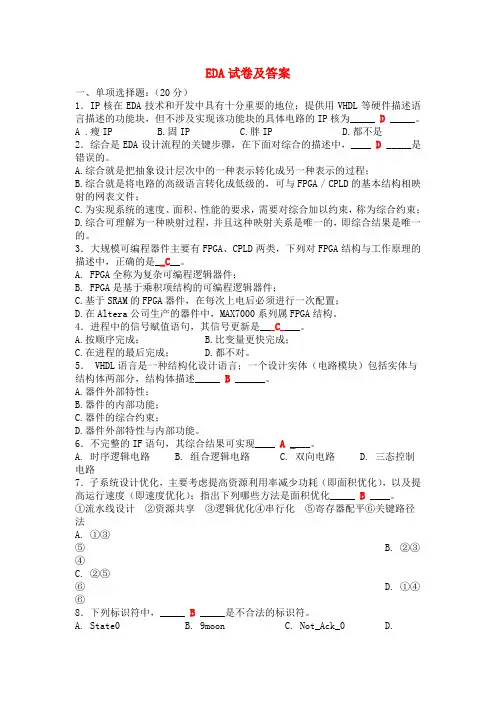
EDA试卷及答案一、单项选择题:(20分)1.IP核在EDA技术和开发中具有十分重要的地位;提供用VHDL等硬件描述语言描述的功能块,但不涉及实现该功能块的具体电路的IP核为_____ D_____。
A .瘦IP B.固IP C.胖IP D.都不是2.综合是EDA设计流程的关键步骤,在下面对综合的描述中,____ D _____是错误的。
A.综合就是把抽象设计层次中的一种表示转化成另一种表示的过程;B.综合就是将电路的高级语言转化成低级的,可与FPGA / CPLD的基本结构相映射的网表文件;C.为实现系统的速度、面积、性能的要求,需要对综合加以约束,称为综合约束;D.综合可理解为一种映射过程,并且这种映射关系是唯一的,即综合结果是唯一的。
3.大规模可编程器件主要有FPGA、CPLD两类,下列对FPGA结构与工作原理的描述中,正确的是__C__。
A. FPGA全称为复杂可编程逻辑器件;B. FPGA是基于乘积项结构的可编程逻辑器件;C.基于SRAM的FPGA器件,在每次上电后必须进行一次配置;D.在Altera公司生产的器件中,MAX7000系列属FPGA结构。
4.进程中的信号赋值语句,其信号更新是___C____。
A.按顺序完成;B.比变量更快完成;C.在进程的最后完成;D.都不对。
5. VHDL语言是一种结构化设计语言;一个设计实体(电路模块)包括实体与结构体两部分,结构体描述_____B______。
A.器件外部特性;B.器件的内部功能;C.器件的综合约束;D.器件外部特性与内部功能。
6.不完整的IF语句,其综合结果可实现____ A ____。
A. 时序逻辑电路B. 组合逻辑电路C. 双向电路D. 三态控制电路7.子系统设计优化,主要考虑提高资源利用率减少功耗(即面积优化),以及提高运行速度(即速度优化);指出下列哪些方法是面积优化_____ B____。
①流水线设计②资源共享③逻辑优化④串行化⑤寄存器配平⑥关键路径法A. ①③⑤ B. ②③④C. ②⑤⑥ D. ①④⑥8.下列标识符中,_____B_____是不合法的标识符。
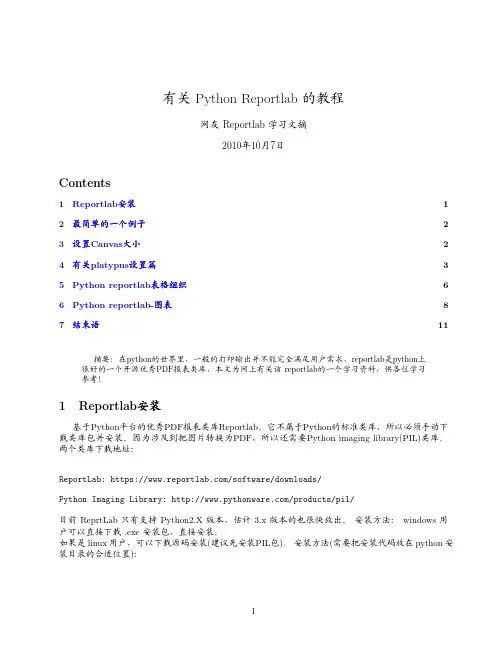
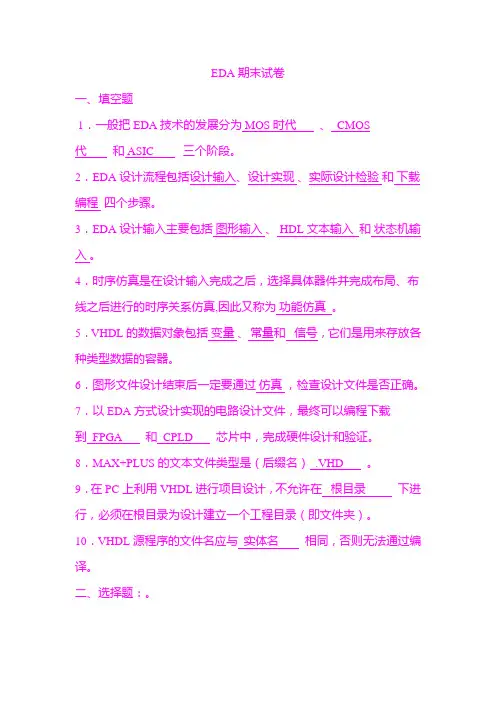
EDA期末试卷一、填空题1.一般把EDA技术的发展分为 MOS时代、 CMOS代和 ASIC 三个阶段。
2.EDA设计流程包括设计输入、设计实现、实际设计检验和下载编程四个步骤。
3.EDA设计输入主要包括图形输入、 HDL文本输入和状态机输入。
4.时序仿真是在设计输入完成之后,选择具体器件并完成布局、布线之后进行的时序关系仿真,因此又称为功能仿真。
5.VHDL的数据对象包括变量、常量和信号,它们是用来存放各种类型数据的容器。
6.图形文件设计结束后一定要通过仿真,检查设计文件是否正确。
7.以EDA方式设计实现的电路设计文件,最终可以编程下载到 FPGA 和 CPLD 芯片中,完成硬件设计和验证。
8.MAX+PLUS的文本文件类型是(后缀名) .VHD 。
9.在PC上利用VHDL进行项目设计,不允许在根目录下进行,必须在根目录为设计建立一个工程目录(即文件夹)。
10.VHDL源程序的文件名应与实体名相同,否则无法通过编译。
二、选择题:。
11.在EDA工具中,能完成在目标系统器件上布局布线软件称为(C )A.仿真器B.综合器C.适配器D.下载器12.在执行MAX+PLUSⅡ的(D )命令,可以精确分析设计电路输入与输出波形间的延时量。
A .Create default symbol B. SimulatorC. CompilerD.Timing Analyzer13.VHDL常用的库是(A )A. IEEEB.STDC. WORKD. PACKAGE 14.下面既是并行语句又是串行语句的是( C )A.变量赋值B.信号赋值C.PROCESS语句D.WHEN…ELSE 语句15.在VHDL中,用语句(D )表示clock的下降沿。
A. clock’EVENTB. clock’EVENT AND clock=’1’C. clock=’0’D. clock’EVENT AND clock=’0’16. IP核在EDA技术和开发中具有十分重要的地位;提供用VHDL 等硬件描述语言描述的功能块,但不涉及实现该功能块的具体电路的IP核为__________。

Unit 5Topic 2 基础练习一、用所给词的适当形式填空。
1. Lily is ( sit ) on the sofa and reading newspapers .2. Jim is ( draw ) a picture there .3. Are you ( write ) a letter to your friend, Jeff ?4. The students are ( have ) an English lesson .5. Look! Lisa is ( make ) a card there .二、按要求完成下面的句子。
1. Some boys are playing soccer on the playground .(对画线部分提问)2.Would you like to dance with me ?(改为同义句)3. Is Michael watching TV now ?(作否定回答)4. Nancy is reading a book in the library .(对画线部分提问)5. Some women often dance on the square .(用now 作时间状语改写句子)三、单项选择。
( )1. --Where is your father ? --He the World Cup in the living room .A . is watchingB . watchesC . watchD . will watch( )2.Mike cards in the classroom now .A . makingB . makeC . is makingD . makes ( )3.-- is your mother? --She is reading books .A . How ; doingB . What ; doC . What ; doingD . How ; do( )4. --Are you cleaning your room now ? --No, .A . I doB . I’mC . I ’ m notD . I don’t( )5. is Li Lei ? --He is in the library .A . WhenB . WhereC . HowD . What( )6.-- ,may I borrow your ruler? -- , I don ’ t have one.A . Excuse me ; Excuse meB . Sorry ; Of courseC . Excuse me ; SorryD . Sorry ; Excuse me( )7. --Excuse me, do you have an eraser?--Sorry! I don’ t have one .-- .A . I’m sorry, tooB . Thank you all the sameC . That’s badD . No problem( )8. --Jane, can I your English book? --Mm, two days.A . How long ; borrowB . How often ; keepC . How long ; keepD . How often ; buy( )9. You can this CD for three days, but you must it to me on time .A . keep ; returnB . borrow ; returnC . keep ; borrowD . borrow ; keep ( )10. Tom is his wallet, but he can’t it .A . finding ; findB . looking for; look forC . looking for ; findD . finding ; look for ( )11. Some boys are in the pool .A. swiming; swimingB. swim; swimmingC. swim; swimD. swimming; swimming ( )12. students in our class can speak Japanese. We all speak Chinese .A . A fewB . LittleC . A littleD . Few( )13. Jane is showing us the school .A . toB . inC . aroundD . about( )14. My sister usually some cleaning after work . But now she songs .A . do ; singsB . doing ; singingC . does ; is singingD . is doing ; sings ( )15. Some students are a soccer game on the playground .A . havingB . playingC . seeingD . looking( )16. Here are some ofA . photos ; himB . picture ; himC . photos ; hisD . pictures ; him( )17.My son draws pictures every evening drawing is his favorite.A . butB . becauseC . orD . so( )18.Mike his English book. He can’t it.A . looking for ; find B. is finding; look forC . looks for ; findD . is looking for ; find( )19.--Ann wants to visit the Great Wall , . What about you?--I want to go .A .to0; tooB . too ; alsoC . also ; tooD . also ; also( )20.I always TV in the evening , but I TV now.A . watch ; watchB . watch ; am watchingC . am watching ; watchD . watching ; watching四、完形填空。
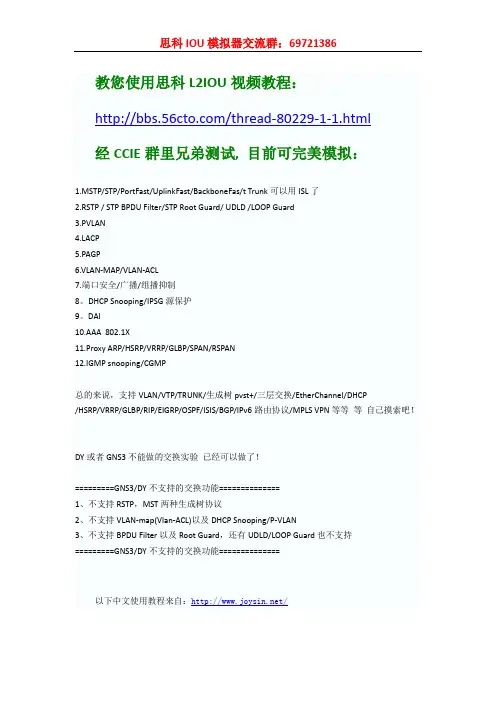
教您使用思科L2IOU视频教程:/thread-80229-1-1.html经CCIE群里兄弟测试, 目前可完美模拟:1.MSTP/STP/PortFast/UplinkFast/BackboneFas/t Trunk可以用ISL了2.RSTP / STP BPDU Filter/STP Root Guard/ UDLD /LOOP Guard3.PVLANCP5.PAGP6.VLAN-MAP/VLAN-ACL7.端口安全/广播/组播抑制8。
DHCP Snooping/IPSG源保护9。
DAI10.AAA 802.1X11.Proxy ARP/HSRP/VRRP/GLBP/SPAN/RSPAN12.IGMP snooping/CGMP总的来说,支持VLAN/VTP/TRUNK/生成树pvst+/三层交换/EtherChannel/DHCP/HSRP/VRRP/GLBP/RIP/EIGRP/OSPF/ISIS/BGP/IPv6路由协议/MPLS VPN等等等自己摸索吧!DY或者GNS3不能做的交换实验已经可以做了!=========GNS3/DY不支持的交换功能==============1、不支持RSTP,MST两种生成树协议2、不支持VLAN-map(Vlan-ACL)以及DHCP Snooping/P-VLAN3、不支持BPDU Filter以及Root Guard,还有UDLD/LOOP Guard也不支持=========GNS3/DY不支持的交换功能==============以下中文使用教程来自:/L2IOU下载:/file/cliafrmy#解压到andLinux的目录下(不会使用andLinux的请百度一下吧),/andlinux/andlinux-beta2-minimal.exe或者你也可以使用Ubuntu。
如下:2. 给这两个文件添加权限3. 执行crack.py文件根据提示,把下面的内容添加到iourc文件中Add the following text to ~/.iourc:[license]andLinux = e5439a28afd220f1;使用vi编辑器创建,然后将上面的高亮内容粘贴进去即可[root@andLinux CiscoIOU]# vi iourc[root@andLinux CiscoIOU]# more iourc[license]andLinux = e5439a28afd220f1;4. 搭建拓扑,以下面的拓扑为例:在这个拓扑中有三台PC,使用交换机来模拟,也就是跟这些交换机一样都使用i86bi_linuxl2-upk9-ms.M镜像,在模拟PC的时候只要把路由功能关闭掉即可(no ip routing)。
现在完成时练习题含答案及解析一、单项选择现在完成时1.T h e G r e e n s_____C h i n a f o r f i v e y e a r s.A.h a s b e e n i n B.h a v e b e e n i nC.w e n t t o D.h a s g o n e t o【答案】B【解析】【详解】考查时态。
句意:G r e e n一家人来中国已经五年了。
时间状语f o r f i v e y e a r s表明用现在完成时,T h e G r e e n s作主语时,谓语动词用复数,而且接一段时间要用h a v e b e e n i n,故B项正确。
2.A l t h o u g h s h e i s o n l y16y e a r s o l d,s h e______t o d r u g s f o rt w o y e a r s.A.a d d i c t s B.h a d b e e n a d d i c t e dC.h a s a d d i c t e d D.h a s b e e n a d d i c t e d【答案】D【解析】【详解】考查现在完成时态和固定搭配。
句意:虽然她只有16岁,但她已经沉迷于毒品两年了。
结合句意可知,这里是指到现在为止已经两年了,与现在有关系,用现在完成时态;b e a d d i c t e d t o沉迷于---,故选D。
3.S h e i s a s t r o n g-w i l l e d w o m a n a n d n o t o n c e_______i n t o a n y d i f f i c u l t y i n h e r l i f e.A.s h e h a s g i v e n B.d i d s h e g i v e C.s h e g a v eD.h a s s h e g i v e n【答案】D【解析】试题分析:考查动词时态和倒装句。
语法综合测试02(形容词和副词、构词法、简单句、句子成分和基本句型、情态动词和虚拟语气)(考试时间:60分钟试卷满分:90分)一、单句语法填空(每题1分,共25小题,总分25分)1.(2024·浙江省杭州市高三上学期一模)The characters depicted(描绘)come________(large)from legends and Chinese opera plots.Da A Fu,a plump(微胖的)boy holding a fish,is the most popular figure in Huishan clay art.2.(2024·浙江省宁波市高三上学期第一次模拟)Beginners are encouraged to start with the most basic movements and____________(gradual)build up their skills and knowledge over time.3.(2024•浙江省温州市高三上学期11月第一次适应性考试)Citywalk is offering a positive change to urban travelers as they can______(well)choose the experiences that fit in with their interests and needs.4.(2024•浙江省温州市高三上学期11月第一次适应性考试)At the same time,Citywalk represents an opportunity for tour guides and travel service providers to offer a more tailored,_______(profession)service to meet ever-changing market demands.5.(2024•浙江省湖州丽水衢州三市期中教学质量检测)Tens of thousands of Chinese social media users have backed calls from the country’s state media to have its artworks_________(current)kept in the British Museum returned.6.(2024•浙江省诸暨中学等2校期中)Global income data tracks closely with emissions data:The World Inequality Lab’s2022report found that the___________(wealthy)10percent earn52percent of all income,while the poorest half of all people earn just8.5percent.7.(2024•河北省省级联测)Zhaoling Tomb is a_______(full)restored tomb according to the old site of the Ming Dynasty,which is magnificent with high pines and glorious halls.8.(2024•河北省省级联测)At present,there is an exhibition of the_________(fine)unearthed cultural relics from the Dingling Tomb in the hall.9.(2024届湖南省永州市高三上学期第一次模拟)Roujiamo is_______(close)associated with the north-central city of Xi’an,in Shaanxi province.Since202BCE,Xi’an has been both the eastern terminal of the Silk Road and the capital for13more-or-less successive Chinese dynasties.10.(2024·广东省佛山市S7高质量发展联盟联考)________(amaze),the lamp makes use of the siphon principle(虹吸原理),with the ash flowing through the maid’s right arm into her body where the water is stored.11.(2024·江苏省句容三中、海安实验中学联考10月月考)The delicate Changxin Palace Lamp provided an insight into China’s glorious past,displaying the wisdom of ancient Chinese craftsmen,as well as China’s_________(remark)achievements in science and technology2,000years ago.The sculpture,vivid and elegant beauty work,still glitters now.12.(2024·河南省TOP二十名校调研)Mobile phones provide a better way of learning and________(fast)access to information.13.(2024·河南省TOP二十名校调研)Mobile phones bring with them many advantages and disadvantages.Let us discuss this to understand the issue_______(clear).14.(2024届湖南省永州市高三上学期第一次模拟)Roujiamo,also called rougamo,is one of the most popular Chinese snacks.Despite its______(compare)to a hamburger,it carries far more geographical and historical meaning.15.(2024·河南省名校联考)Tai Shan is(popular)panda,with the most fans worldwide.16.(2024·河南省名校联考)In2007,due to strong demand from the US public,the Chinese government agreed to extend Tai Shan’s stay in the United States for an_______(addition)two years.17.(2024·河南省名校联考)In1869,the French_______(natural)and missionary Armand David,introduced the unique animal to the Western world.18.(2024•河南省名校联考)There are_______(current)1,864wild giant pandas in China and at the end of last year,there were another698in captivity.19.(2024·江苏省南通市统考)Chinese archaeologists have unearthed a big bronze beast.It’s one of the most highly_______(anticipate)treasures of the Sanxingdui Ruins.20.(2024·江苏省南通市统考)The bronze animal is the_______(big)ever found in decades of digging at the Sanxingdui Ruins.21.(2024·江苏省南通市统考)UNESCO sent_______(congratulate)on the amazing new discovery through a video.22.(2024·山东省潍坊市(安丘、高密、诸城)过程性检测)A black slate(石板),an alloy steel needle and decades of practice are_______Li Yahua needs to create the perfect Huihe stone shadow carving work of art.23.(2024·北京市海淀区期中)_______(difference)from traditional Chinese art types that emphasize the beauty of lines,stone shadow carving highlights the size and_________(deep)of dots.24.(2024·北京市丰台区期中)Males have larger vocal folds that create a lower sound,and females have smaller ones.Apart from the difference size,however,the other major biological difference that effects voices is that males generally have a larger vocal tract,which can further lower the tone.25.(2024·江苏省前黄高级中学第一次阶段考)A study recently published in the Journal of Nonverbal Behavior shed new light on the bias.Different from previous studies,not only looked to see whether people associate positive traits with good-looking people(we know they do),but also took a closer look at which traits are associated with appearance,with two tests respectively focused on purely moral traits,such as being fair, trustworthy,or honest,and positive but non-moral traits,such as being funny,organized,or calm.二、猜测词义(猜测划线部分的词义)(每题1分,共5小题,总分5分)1.(2020•全国卷I)Now that you’ve listed your strengths,list your imperfections.2.(2022•新高考全国II卷)We journalists live in a new age of storytelling,with many new multimedia tools. 3.(2023•新高考全国Ⅱ卷)Jaramillo’s students live in neighbourhoods where fresh food and green space are not easy to find and fast food restaurants outnumber grocery stores.4.(2020•全国新高考I卷)Mrs Meredith was a most kind and thoughtful woman.She spent a great deal of time visiting the poor.She knew they had problems,and they needed all kinds of help.5.The music room had been made to reflect and deepen sounds.二、阅读下面短文,在空白处填入1个适当的单词或括号内单词的正确形式。
All contents are Copyright © 1992–2007 Cisco Systems, Inc. All rights reserved. This document is Cisco Public Information. Page 1 of 7 Lab 4.5.1: Observing TCP and UDP using Netstat (Instructor Version) Topology Diagram
Addressing Table Device Interface IP Address Subnet Mask Default Gateway R1-ISP S0/0/0 10.10.10.6 255.255.255.252 N/A Fa0/0 192.168.254.253 255.255.255.0 N/A
R2-Central S0/0/0 10.10.10.5 255.255.255.252 10.10.10.6 Fa0/0 172.16.255.254 255.255.0.0 N/A
Eagle Server N/A 192.168.254.254 255.255.255.0 192.168.254.253
N/A 172.31.24.254 255.255.255.0 N/A
hostPod#A N/A 172.16.Pod#.1 255.255.0.0 172.16.255.254 hostPod#B N/A 172.16.Pod#.2 255.255.0.0 172.16.255.254 S1-Central N/A 172.16.254.1 255.255.0.0 172.16.255.254 CCNA Exploration Network Fundamentals: OSI Transport Layer Lab 4.5.1: Observing TCP and UDP using Netstat
All contents are Copyright © 1992–2007 Cisco Systems, Inc. All rights reserved. This document is Cisco Public Information. Page 2 of 7 Learning Objectives • Explain common netstat command parameters and outputs. • Use netstat to examine protocol information on a pod host computer.
Background netstat is an abbreviation for the network statistics utility, available on both Windows and Unix / Linux computers. Passing optional parameters with the command will change output information. netstat displays incoming and outgoing network connections (TCP and UDP), host computer routing table information, and interface statistics.
Scenario In this lab the student will examine the netstat command on a pod host computer, and adjust netstat output options to analyze and understand TCP/IP Transport Layer protocol status.
Depending on the classroom situation, the lab topology may have been modified before this class. It is best to use one host to verify infrastructure connectivity. If the default web page cannot be accessed from eagle-server.example.com, troubleshoot end-to-end network connectivity: 1. Verify that all network equipment is powered on, and Eagle Server is on. 2. From a known good host computer, ping eagle-server.example.com. If the ping test fails, ping S1-Central, R2-Central, R1-ISP, and finally eagle-server. Take corrective action on devices that fail ping tests. 3. If an individual host computer cannot connect to Eagle Server, check the cable connection between the host and S1-Central. Verify that the host computer has the correct IP address, shown in the logical addressing table above, and can ping R2-Central, 172.16.255.254. Verify that the host computer has the correct Gateway IP address, 172.16.255.254, and can ping R1-ISP, 10.10.10.6. Finally, verify that the host has the correct DNS address, and can ping eagle-server.example.com.
Task 1: Explain common netstat command parameters and outputs. Open a terminal window by clicking on Start | Run. Type cmd, and press OK. To display help information about the netstat command, use the /? options, as shown: C:\> netstat /? CCNA Exploration Network Fundamentals: OSI Transport Layer Lab 4.5.1: Observing TCP and UDP using Netstat
All contents are Copyright © 1992–2007 Cisco Systems, Inc. All rights reserved. This document is Cisco Public Information. Page 3 of 7 Use the output of the netstat /? command as reference to fill in the appropriate option that best matches the description:
Option Description Display all connections and listening ports. Display addresses and port numbers in numerical form. Redisplay statistics every five seconds. Press CTRL+C to stop redisplaying statistics. Shows connections for the protocol specified by proto; proto may be any of: TCP, UDP, TCPv6, or UDPv6. If used with the –s option to display per-protocol statistics, proto may be any of: IP, IPv6, ICMP, ICMPv6, TCP, TCPv6, UDP, or UDPv6.
Redisplay all connections and listening ports every 30 seconds. Display only open connections. This is a tricky problem.
Answer: Option Description -a Display all connections and listening ports. -n Display addresses and port numbers in numerical form. 5 Redisplay statistics every five seconds. Press CTRL+C to stop redisplaying statistics. -p Shows connections for the protocol specified by proto; proto may be any of: TCP, UDP, TCPv6, or UDPv6. If used with the –s option to display per-protocol statistics, proto may be any of: IP, IPv6, ICMP, ICMPv6, TCP, TCPv6, UDP, or UDPv6.
-an 5 Redisplay all connections and listening ports every 30 seconds. No options Display only open connections. This is a tricky problem.